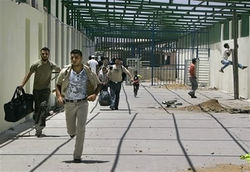UnNews:Super-real action film being shot in Libya
14 May 2011
MISRATA, Libya -- Missiles fall from the sky and slam into buildings, igniting in balls of fire when they impale the sides of houses. Rock, wood, flesh and blood splinter and explode from the burning flame. When the smoke settles, there is nothing left of the building; only shards of the walls, some furniture, and the gore of bodies crushed beneath the rubble. There is screaming as people, men and women, young and old, flee from the destruction that's killed 4 more civilians in the rebel stronghold of Misrata. But Tyler Reed only smiles; he caught all of it on camera.
"I was looking right at that building when the missile hit; there was some woman on the top floor crying because she's just been told her son had been killed in the fighting and then BAM, the rocket nailed her," Reed says, replaying the footage on his digital camera and ignoring the sound of more explosions down the street, "Best shots I've had so far; had both action and drama. Simply beautiful."
Reed is one of a number of cameramen sent to the war torn region by the film studio New Line Cinema to collect as much footage of the revolution as possible. But this isn't for a documentary, and these shots will never make the evening news: This is the film studio's daring new approach to making movies, and it's turning heads.
"We're witnessing a revolution in the methods of filming; a movement towards reality. Cloverfield introduced the 'shaky camera' perspective, eliminating the separation between audience and the film caused by the stilted and unmoving perspective. Avatar mainstreamed 3D viewing, turning the flat movie screen into a realistic simulation of the world as we see it. Gadhafi is eliminating the idea of the movie set by shooting real events, creating a hyper-realistic film experience."
"There's been a movement in Hollywood towards more and more realistic films," New Line Cinema president Toby Emmerich observed, "and this is just the logical next step."
Insiders with access to the movie in progress, tentatively titled Gadhafi, have nothing but praise for the new methods. "The cast is huge, the action intense, the drama realistic... And the best thing is it saves money; none of the 'actors' know they're being filmed, and the production company doesn't even need a screenwriter!"
Arming a veritable army of cameramen with top-of-the-line cameras that capture footage 24-hours of the day and upload their findings instantly to their database, New Line's strategy is to capture as many minutes of film as possible during the siege of the rebel city. Once their databases are full (they can hold approximately 3 years worth of film), the director will lead a team of writers to mash up the footage and organize a plot, adding to the pile of raw video more footage of battles taking place outside of the city. Then a squad of video editors will manipulate the images to tie up any loose ends or make any changes necessary to make the film flow better.
But right now, the only goal is to get the raw footage, and that's where people like Tyler Reed come in.
Faced with little other options after graduating from an expensive film school that put him nearly $60,000 in debt, Reed and countless others bit when New Line Cinema's made the announcement that they were not only hiring cameramen, but were also willing to pay nearly triple the going rate. "New Line was even up front about the dangers of the job, and they were very clear about the stipulations of the pay check," fellow filmmaker Norene Norman recalls, "I knew from the beginning that I would only get paid if I got back to the states alive, but they offered to pay off all my school loans if I died, so I couldn't say no."
Despite 13% of the cameramen missing and presumed dead, New Line claims to have filled it's waiting list with more potential employees, and are only held back by the limited number of camera's in their studio. They intend to continue capturing film until the end of the Libyan revolution, and have predicted the movie's release, in 3D, sometime in August of 2012.
Sources[edit | edit source]
- Sara Sidner "Wounded tell of hell in besieged Misrata" CNN, May 9, 2011
